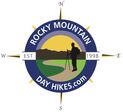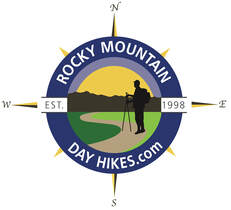|
Notes from the
Trail |
|
by Barb Boyer Buck A father fights for a better life for his children, a grandfather spoils them. A father shows his offspring how to be productive citizens of the world by teaching them the valuable lessons he has learned. A grandfather rests on the wealth of his knowledge and experience and shares these, generously and without condition, with his grandchildren. Such are the patriarchs of the Estes Valley, Enos Mills and FO Stanley, the leaders who are credited with the development and the establishment of Rocky Mountain National Park and the Town of Estes Park.
She can be seen from miles East. This striking landmark is named for the man who first spotted her on behalf of the US Government in 1820, Major Stephen Long. But thousands of years before that, Longs and her sister, Mount Meeker (13,911 ft.), were designated the “two guides” by the indigenous people who made what is now the northern plains of Colorado part of their territory. These nomads followed their “guides” all the way up to the top of the Divide, to the alpine tundra which thrives where it’s too high for trees to grow. There, they hunted the now-extinct mountain bison, and elk. It was their summer home, a very fat and sweet season. Longs Peak has inspired a painting by Albert Bierstadt, a photograph by Ansel Adams, amazing prose, countless songs, and thousands of climbers to conquer that unmovable monarch. When he was 14 years old, Mills was sent by his family to seek the “mountain cure” at his relative’s homestead. The Reverend Elkanah Lamb, cousin to Mills’ mother, lived in the Tahosa Valley, south of Estes Park, with Longs Peak towering over it. Ever since and for the rest of his life, this peak consumed Mills’ activities and ponderings. When he first arrived in 1884 he was frail, suffering from an undiagnosed allergy to the wheat his family farmed. (Today, we call that celiac disease.) At first, he couldn’t climb Longs Peak at all. As he regained his health in the mountain air of the Rockies, Enos guided guests to the top of Longs frequently; he summited the peak 297 times in his lifetime. He loved her so much he was eventually inspired to take up the fight for the conservation of the land she sits on. Enos spent winters away from the homestead working at various mining operations until a fire at the Anaconda Copper Mine in Butte, Montana, put him out of work in the fall of 1889. Visitors would not arrive to Longs Peak House (Lamb’s establishment which was later purchased by Mills) until summer, so it freed the young man to travel to places he had never been. While visiting a beach in San Francisco later that year, Mills listened to a speech by John Muir who disparaged the west’s prevailing philosophy of homesteading. People do not have a divine right to the indiscriminate use of surrounding natural resources while establishing a home or eking out a living, Muir positioned. This California naturalist and champion for Yosemite National Park would become his lifelong friend and mentor. Mills soon began to question his choice of employment in the mines. He studied conservation and began writing his own pieces on the subject. When guiding his summer guests around the Estes Valley and up Longs Peak, Mills spoke of the negative impact humans can have on nature. Visitors were chastised for picking wildflowers and encouraged to get out into the wilderness every day of their visit. Eventually he became Colorado’s official snow recorder, snowshoeing the high ridges of the Continental Divide to measure snow-pack with his trusty dog Scotch by his side. He was soon inspired to take on the cause for creating Rocky Mountain National Park. Mills’ original plan for the national park included 1,000 square miles of Colorado’s Rocky Mountains, extending from Colorado Springs to the Wyoming border. But the Rocky Mountains contained valuable minerals, including gold. The Colorado Gold Rush which began in 1858 was instrumental in the formation of the state of Colorado in 1876. There was money to be made from logging as well. Conservation was a very hard sell in the west during the 19th Century. This was a difficult time for Enos Mills, living in the Estes Valley. Local residents – all homesteaders – resented his work in conservation and felt personally threatened by his idea of creating a national park in their backyard. Sewer lines were run onto his land and his cattle were reportedly poisoned. History may look upon Enos Mills as one of the most visionary men of his time, but his neighbors saw him as a dangerous pariah and meted out frontier justice with the conviction of self-made pioneers. Mills began to travel the country and speak on naturalist subjects and the proposed Rocky Mountain National Park. He gained enough support and influence to see his dream realized – America’s 10th National Park was established on January 26, 1915, and dedicated in September of that year. But it only contained a little more than 350 square miles. Subsequent acquisitions grew the Park to what it is today. FO Stanley, “the grandfather of Estes Park,” also came to the area for health concerns – and he didn’t exactly fit in with his new neighbors, either. Estes Park residents first heard of his arrival in the early summer of 1903 when he completed the 16-mile trip from Lyons to Estes Park in less than two hours via the Stanley Steamer, a feat none thought possible. FO invented the Stanley Steamer (a steam-powered motor car) with his twin brother, FE Stanley. They were raised in Kingston, Maine, and these brilliant men are credited with another remarkable invention: dry plate photography. They sold this technology to George Eastman who went on to establish the Eastman/Kodak company. But by the time he was 50, FO suffered from tuberculosis and he left his home with his wife, Flora, to seek the dry mountain air of Colorado. When he first arrived in Estes Park, crowned by the indomitable Longs Peak, he was smitten by its beauty. Imagine the reaction of the earliest Estes Park pioneers when they first saw Stanley sputter into town in his motor car, backed by the wealth of his established family and the many successes he and his brother realized. Within several years, he announced his intention to build a luxury hotel, complete with running water and electricity. This was a crazy plan, thought most of the locals, and viewed his activity with suspicion. But Stanley’s innovative developments proved beneficial for the entire community. To generate electricity, he established a hydroplant at Fall River and built distribution lines from the operation to his hotel. Along the way, he sold electricity to residents by selling them light bulbs. He established the area’s first water distribution system, too, by feeding the waters of Black Canyon creek directly to his hotel via wooden pipes lined with pitch. When the doors opened in 1909, the Stanley Hotel greeted its guests with a stunning view of Longs Peak, a flood of electric lights, and hot-and-cold running water, amenities unheard of in the remote Colorado mountains at that time. It was his kindness and generosity he extended to the children of Estes Park that first earned him the moniker “grandfather of Estes Park.” He would give children trinkets and dimes and would often stop to give them rides in his steam car.
Although both men were initially treated with attitudes ranging from skepticism to outright hostility, Mills and Stanley are now viewed as the most important contributors to area’s development and preservation. As it is can be with any good parent or grandparent, their efforts in guiding and providing for their “children” were misunderstood at the time. In Estes Park this morning, looking at the unspoiled views surrounding Longs Peak, gratitude fills my soul. Thanks, Dad. Thanks, Grandpa.
0 Comments
Leave a Reply. |
"The wild requires that we learn the terrain, nod to all the plants and animals and birds, ford the streams and cross the ridges, and tell a good story when we get back home." ~ Gary Snyder
Categories
All
“Hiking -I don’t like either the word or the thing. People ought to saunter in the mountains - not hike! Do you know the origin of the word ‘saunter?’ It’s a beautiful word. Away back in the Middle Ages people used to go on pilgrimages to the Holy Land, and when people in the villages through which they passed asked where they were going, they would reply, A la sainte terre,’ ‘To the Holy Land.’ And so they became known as sainte-terre-ers or saunterers. Now these mountains are our Holy Land, and we ought to saunter through them reverently, not ‘hike’ through them.” ~ John Muir |
© Copyright 2025 Barefoot Publications, All Rights Reserved






